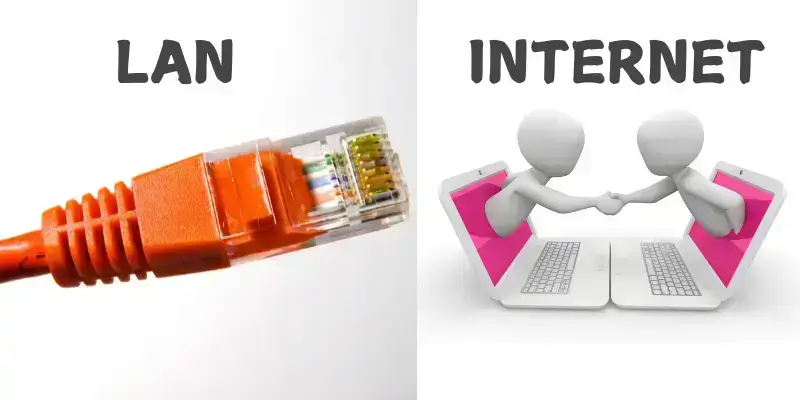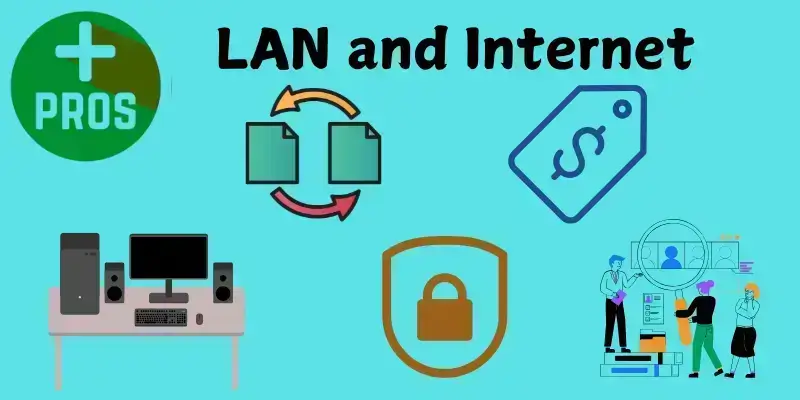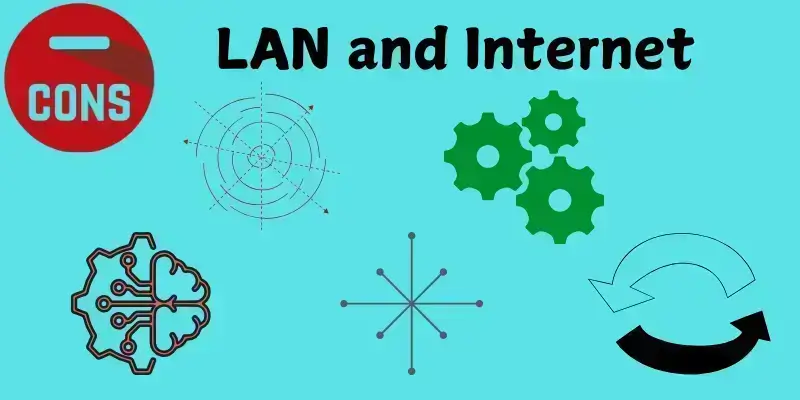Difference Between LAN Vs Internet
Published: February 4, 2025
Are you often confused about the difference between LAN and the Internet? It’s easy to mix them up since both provide network connectivity. However, their scope, purpose, and even how they function can be very different. Let’s break down how they compare to avoid any confusion.

What is the Local Area Network (LAN)?
A Local Area Network (LAN) is a system that connects computers and devices within a small area, such as a home, office, or school. It helps users share resources like files, printers, and internet access quickly and easily. LANs are fast, reliable, and simple to set up.
How LAN Works
LAN works by connecting devices through wired or wireless connections. Devices share data using a central device, like a router or switch. When a device asks for data, the network sends it to the right place, making communication smooth and easy.
Components of a LAN
A LAN consists of several essential components that ensure seamless connectivity and communication:
1. Router
Directs traffic between networks and provides internet access.
2. Switch
Connects multiple devices within the LAN and efficiently manages data traffic.
3. Cables
Used in wired LANs to connect computers and network devices.
4. Wi-Fi
Wireless access points that enable wireless communication within a LAN.
Wired vs. Wireless LAN
There are two primary types of LANs based on connectivity:
1. Wired LAN
Uses Ethernet cables to connect devices. It offers higher speed, reliability, and security but requires physical infrastructure.
2. Wireless LAN (WLAN)
Uses Wi-Fi signals for connectivity. It provides flexibility and mobility but may be susceptible to interference and lower security than wired LANs.
Types of LANs
LANs can be classified based on how they are structured and function:
1. Peer-to-Peer LAN
In a Peer-to-Peer (P2P) LAN, devices connect directly to each other without a central server. Each device has equal privileges; users can share files and resources without a dedicated network administrator. This setup is common in small offices and home networks.
2. Client-Server LAN
A Client-Server LAN consists of client devices that request services from a central server. The server manages data, applications, and security, making this type of LAN suitable for larger organizations, businesses, and educational institutions.
3. Virtual LAN (VLAN)
A Virtual LAN (VLAN) segments a physical network into multiple logical networks. It improves security, efficiency, and performance by grouping devices based on departments or functions rather than physical locations.
Common Uses of LAN
LANs are widely used in various settings to improve communication, collaboration, and resource sharing.
1. Home and Office Networking
LANs connect computers, printers, and smart devices in homes and offices, enabling efficient internet sharing, file transfers, and centralized data storage.
2. Educational Institutions
Schools and universities use LANs for computer labs, online learning platforms, and administrative systems. LANs enhance student collaboration and streamline communication between faculty and staff.
3. Gaming Networks
Many gaming enthusiasts and businesses set up LANs for multiplayer gaming. LAN gaming offers low latency, faster response times, and an uninterrupted gaming experience.
What is the Internet?
The Internet is a global network of computers and servers that lets people exchange data and communicate. It connects people, devices, and information worldwide, making it an essential tool for daily life.
How the Internet Works
When you visit a website or send information, your device communicates with the Internet via an Internet Service Provider (ISP). The data travels through servers, cables, and routers to reach its destination, ensuring you get the right information quickly.
ISPs (Internet Service Providers)
ISPs are companies that provide internet access. They connect homes and businesses to the Internet using different technologies like fiber-optic cables or satellites. ISPs ensure smooth, reliable internet connections.
Servers and Data Centers
Servers store and manage data on the Internet. When you visit a website, the server sends the requested data to your device. These servers are housed in data centers, large buildings designed to store many servers securely and keep them running efficiently.
Protocols (TCP/IP, HTTP, HTTPS)
Protocols are the rules that govern how data is transmitted over the Internet. Some key protocols include:
1. TCP/IP (Transmission Control Protocol/Internet Protocol)
It is the fundamental protocol that allows devices to communicate over the Internet. TCP/IP ensures data is sent and received correctly, while IP directs data to the right destination.
2. HTTP (Hypertext Transfer Protocol)
HTTP transfers web pages from a server to a user’s device. It’s the protocol that allows you to view websites.
3. HTTPS (Hypertext Transfer Protocol Secure)
HTTPS is a secure version of HTTP. It encrypts data to protect sensitive information like passwords or credit card details when you browse websites.
Types of Internet Connections
Several types of internet connections offer different speeds and reliability. The most common types include:
1. Dial-up
It is one of the oldest types of internet connection. It uses a phone line to access the Internet but is slow and outdated.
2. DSL (Digital Subscriber Line)
DSL uses a phone line to provide faster speeds than dial-up. It’s widely available but not as fast as other types of connections.
3. Cable
Cable internet uses coaxial cables, which are typically faster than DSL. It’s popular in urban areas.
4. Fiber-optic
Fiber-optic Internet is one of the fastest available options. It uses light signals to transmit data through glass or plastic fibers, allowing high-speed connections over long distances.
5. Satellite
Satellite internet is an option for rural areas without other connections. However, it can be slower due to the long distances that data travels.
Common Uses of the Internet
The Internet is used for various activities, including:
1. Browsing
People use the Internet to browse websites for information, news, and entertainment. Browsers like Chrome, Safari, and Firefox allow users to navigate the web.
2. Streaming
Streaming platforms like Netflix, YouTube, and Spotify let users watch movies and TV shows and listen to music without downloading the content. Streaming has become a major part of how people consume media.
3. Online Communication
The Internet allows for email, social media, and instant messaging. Communication tools like Skype, Zoom, and WhatsApp allow people to connect with others in real time, whether for work or socializing.
4. Cloud Computing and Remote Work
Cloud computing allows users to store data and access applications online rather than on a local device. It has made remote work more accessible, enabling people to work from anywhere as long as they have an internet connection.
Key Differences Between LAN and Internet
| Feature | LAN | Internet |
| Coverage | Local (small area) | Global (worldwide) |
| Speed | High speed (1Gbps-10Gbps) | Varies based on connection |
| Ownership | Private | Public and private |
| Security | More secure | More vulnerable to attacks |
| Usage | Internal communication | Browsing, emails, social media |
Comparison between Advantages of LAN and Internet

| Feature | LAN | Internet |
| Data Transfer Speed | Fast data transfer within a limited area | Can be slow depending on the connection type |
| Resource Sharing | Devices can share resources like printers and files | Wide access to information, services, and resources |
| Cost | Cost-effective for small-scale setups | Generally requires higher costs for better services |
| Security | More secure due to limited access to physical location | Vulnerable to hacking, phishing, and cyber threats |
| Setup Complexity | Easier to set up for small networks | Requires complex setup for global connectivity |
Comparison between DisAdvantages of LAN and Internet

| Feature | LAN | Internet |
| Range | Limited to a small geographic area (e.g., office, home) | Global reach, no physical limitations |
| Maintenance | Requires ongoing maintenance, especially in larger setups | Requires ongoing network and server maintenance |
| Network Congestion | Can experience slowdowns if the network is overloaded | Can slow down during peak times or with slow connections |
| Scalability | Less scalable for large or remote locations | Highly scalable for large and distributed systems |
| Dependence | Works independently without internet connection | Requires stable internet connection to function |
How LAN and the Internet Work Together
A Local Area Network (LAN) connects devices like computers, printers, and phones within a small area, such as a home or office. To access the internet, the LAN needs a router and a modem.
Connecting LAN to the Internet
A router connects the LAN to the internet. It acts as a bridge, allowing devices on the LAN to send and receive data from the internet. The modem is connected to the router and converts the internet data from the service provider into a form the router can use. The modem connects directly to the internet via a cable.
Role of ISPs
An Internet Service Provider (ISP) provides the Internet connection. The ISP sends data through the modem to the router. Without the ISP’s connection, the LAN cannot access the internet. ISPs offer different plans depending on how fast or how much data is needed.
Examples of LANs Accessing the Internet
1. Home Wi-Fi
A Wi-Fi router connects phones, laptops, and other devices to the internet at home. The router gets its internet connection from the ISP through a modem.
2. Office Networks
In offices, a LAN connects computers, printers, and other devices. The office router connects the LAN to the internet, allowing employees to use online services.
Which One Do You Need?
When deciding whether to use a Local Area Network (LAN) or the Internet, it’s important to know when each is needed and if you can have one without the other.
1. When to Use a LAN
Use a LAN when connecting devices in a small area like a home or office. A LAN is the best option if you want devices to share files, printers, or other resources locally.
Example
In an office, a LAN allows computers to share files and printers without needing the internet.
Benefits
LANs are fast, secure, and cost-effective for local connections.
2. When to Rely on the Internet
The internet is needed to access websites, send emails, watch videos, or use online services. The internet is essential if you need global access to information or communication.
Example
If you want to check your email or shop online, you need the internet.
Benefits
The internet connects you to everything worldwide, from social media to services.
3. Can You Have One Without the Other?
You can have one without the other, but there are limitations:
LAN Without the Internet
You can have a LAN without the internet. For example, a company might use a LAN to connect devices locally without the internet.
Internet Without LAN
You can use the internet without a LAN, but you’ll only connect one device at a time and won’t be able to share files or resources between devices.
Conclusion
In summary, Local Area Networks (LAN) and the Internet serve different but equally important purposes. A LAN connects devices within a small, local area, like a home or office, allowing fast, secure data transfer and resource sharing. It’s ideal when you only need local communication and don’t require global access. On the other hand, the Internet connects users to a vast network of global resources, enabling activities like browsing websites, sending emails, and using online services. It’s essential for accessing information and communicating with people around the world.
Both LANs and the Internet are crucial for daily life. LANs provide the infrastructure for smooth local communication and resource sharing, while the Internet offers endless opportunities for learning, work, and entertainment. Together, they ensure seamless connectivity at home or in the office.
Looking ahead, the future of networking and connectivity is likely to become even more integrated and efficient. With advancements like 5G technology, the Internet of Things (IoT), and cloud computing, both LANs and the Internet will continue to evolve. These changes will lead to faster, more reliable connections and allow for smarter, more connected devices in homes and businesses. As technology progresses, the distinction between LANs and the Internet may blur, creating a more seamless and powerful network experience for everyone.
FAQS About LAN Vs Internet
A LAN (Local Area Network) is a private network within a small area like a home or office, while the Internet is a global network connecting people and devices worldwide. LAN is used for local connections, while the Internet connects you to the world.
Yes, a LAN can work without the Internet. It’s used for local file sharing and connecting devices within a small area, even without an Internet connection.
Yes, LAN is usually faster than the Internet. Since it’s a local connection, it doesn’t face the slowdowns that might occur over long-distance Internet connections.
Yes, the Internet can be accessed through a LAN. The LAN connects to a router or modem, which then provides access to the Internet.
No, the Internet is not always connected to a LAN. A LAN can function without an Internet connection, but for web browsing or online activities, the LAN needs an Internet connection.
You don’t need a LAN to access the Internet. You can access the Internet using mobile data or Wi-Fi networks, but LAN can improve local device communication.
A LAN is usually more secure because it’s a private network, limiting access to a small group of people. The Internet, being public, is more vulnerable to hackers and security risks.
Yes, you can use both at the same time. A LAN can be used for local communication, and the Internet can be accessed through the same network for global connectivity.
No, LAN is designed for local use. It doesn’t work outside the network’s range unless you connect it to the Internet or use a Virtual Private Network (VPN).
Generally, the Internet is more expensive. You pay for the Internet service through an ISP, while setting up a LAN is usually cheaper and involves only the cost of networking equipment.





